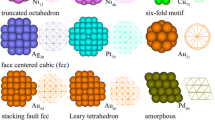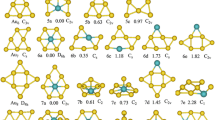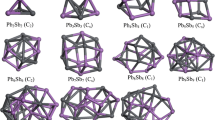Abstract
The structure, stability, and electronic properties of Pd n Au (n = 3~20) clusters are studied by density functional theory. The results show that the clusters studied here prefer three-dimensional structures even with very small atom number. It is found that the binding energies of Pd n Au clusters are higher than the corresponding pure Pd n clusters with the same atom number. Most Pd n Au clusters studied here are magnetic with magnetic moments ranging from 1.0 to 7.0 μ B. The dissociation energies of Pd atoms are lower than the doped gold atom, that is the doped Au atom will increase the mother clusters stability and activity.






Similar content being viewed by others
References
Banerjee R, Katsenovich Y, Lagos L, McIintosh M, Zhang X, Li CZ (2010) Nanomedicine: magnetic nanoparticles and their biomedical applications. Curr Med Chem 17:3120–3141
BLOCHL P (1994) Projector augmented-wave method. Phys Rev B 50:17953–17979
Chen M, Kumar D, Yi C (2005) The promotional effect of gold in catalysis by palladium-gold. Science 310:291–293
Cui X et al (2001) Reproducible measurement of single-molecule conductivity. Science 294:571–574
Deka A, Deka RC (2012) A density functional study on equilibrium geometries, stabilities and electronic properties of Au5Li binary clusters. Appl Nanosci 2:359–364
Edwards JK, Solsona B, N EN, Carley AF, Herzing AA, Kiely CJ, Hutchings GJ (2009) Switching off hydrogen peroxide hydrogenation in the direct synthesis process. Science 323:1037–1041. doi:10.1126/science.1168980
Enache DI et al (2006) Solvent-free oxidation of primary alcohols to aldehydes using Au-Pd/TiO2 catalysts. Science 311:362–365. doi:10.1126/science.1120560
Frimpong RA, Hilt JZ (2010) Magnetic nanoparticles in biomedicine: synthesis, functionalization and applications. Nanomedicine 5:1401–1414. doi:10.2217/nnm.10.114
Giljohann DA, Seferos DS, Daniel WL, Massich MD, Patel PC, Mirkin CA (2010) Gold nanoparticles for biology and medicine. Angew Chem-Int Edit 49:3280–3294. doi:10.1002/anie.200904359
Guo JJ, Yang JX, Die D (2006a) First principle calculation on AunPt2 (n=1-4) clusters theochem. J Mol Struct 764:117–121. doi:10.1016/j.theochem.2006.02.014
Guo JJ, Yang JX, Die D (2006b) Quantum-mechanical study of small Au2Pdn (n=1 similar to 4) clusters. Commun Theor Phys 46:155–160
Gupta AK, Naregalkar RR, Vaidya VD, Gupta M (2007) Recent advances on surface engineering of magnetic iron oxide nanoparticles and their biomedical applications. Nanomedicine 2:23–39. doi:10.2217/17435889.2.1.23
Han G, Ghosh P, Rotello VM (2007) Functionalized gold nanoparticles for drug delivery. Nanomedicine 2:113–123. doi:10.2217/17435889.2.1.113
Hao R, Xing RJ, Xu ZC, Hou YL, Gao S, Sun SH (2010) Synthesis, functionalization, and biomedical applications of multifunctional magnetic nanoparticles. Adv Mater 22:2729–2742. doi:10.1002/adma.201000260
Jiang DE, Whetten RL (2009) Magnetic doping of a thiolated-gold superatom: first-principles density functional theory calculations. Phys Rev B 80:5. doi:10.1103/PhysRevB.80.115402
Jin Y, Tian Y, Kuang X, Lu C, Cabellos JL, Mondal S, Merino G (2016) Structural and electronic properties of ruthenium-doped germanium clusters. J Phys Chem C 120:8399–8404
Kimble ML, Moore NA, Johnson GE, Castleman A Jr, Bürgel C, Mitrić R, Bonačić-Koutecký V (2006) Joint experimental and theoretical investigations of the reactivity of Au 2 O. J Chem Phys 125:204311
Kresse G, Furthmuller J (1996) Efficiency of ab-initio total energy calculations for metals and semiconductors using a plane-wave basis set. Comput Mater Sci 6:15–50
McCarthy JR, Kelly KA, Sun EY, Weissleder R (2007) Targeted delivery of multifunctional magnetic nanoparticles. Nanomedicine 2:153–167. doi:10.2217/17435889.2.2.153
Namdeo M, Saxena S, Tankhiwale R, Bajpai M, Mohan YM, Bajpai SK (2008) Magnetic nanoparticles for drug delivery applications. J Nanosci Nanotechnol 8:3247–3271. doi:10.1166/jnn.2008.399
Pankhurst Q, Connolly J, Jones S (2003) Applications of magnetic nanoparticles in biomedicine. Journal of Physics D-Applied Physics 36:R167–R181
Perdew JP, Burke K, Ernzerhof M (1996) Generalized gradient approximation made simple. Phys Rev Lett 77:3865
Perdew JP, Chevary JA, Vosko SH, Jackson KA, Pederson MR, Singh DJ, Fiolhais C (1992) Atoms, molecules, solids, and surfaces: applications of the generalized gradient approximation for exchange and correlation. Phys Rev B 46:6671–6687
Pittaway F et al (2009) Theoretical studies of palladium-gold nanoclusters: Pd-Au clusters with up to 50 atoms. J Phys Chem C 113:9141–9152. doi:10.1021/jp9006075
Pyykkö P (2004) Theoretical chemistry of gold. Angew Chem Int Ed 43:4412–4456
Sanchez A, Abbet S, Heiz U, Schneider W-D, Häkkinen H, Barnett R, Landman U (1999) When gold is not noble: nanoscale gold catalysts. J Phys Chem A 103:9573–9578
Sandhu A, Handa H, Abe M (2010) Synthesis and applications of magnetic nanoparticles for biorecognition and point of care medical diagnostics. Nanotechnology 21. doi:10.1088/0957-4484/21/44/442001
Sun C, Lee JSH, Zhang M (2008) Magnetic nanoparticles in MR imaging and drug delivery. Adv Drug Deliv Rev 60:1252–1265. doi:10.1016/j.addr.2008.03.018
Tan TL, Wang LL, Johnson DD, Bai KW (2012) A comprehensive search for stable Pt-Pd nanoalloy configurations and their use as tunable catalysts. Nano Lett 12:4875–4880. doi:10.1021/nl302405k
Valden M, Lai X, Goodman DW (1998) Onset of catalytic activity of gold clusters on titania with the appearance of nonmetallic properties. Science 281:1647–1650
Wang J, Bai J, Jellinek J, Zeng XC (2007) Gold-coated transition-metal anion Mn-13@Au-20 (-) with ultrahigh magnetic moment. J Am Chem Soc 129:4110. doi:10.1021/ja0664234
Wang L-M et al (2009) Magnetic doping of the golden cage cluster M@Au-16(-) (M=Fe,Co,Ni). Phys Rev B 79. doi:10.1103/PhysRevB.79.033413
Wang SJ, Kuang XY, Lu C, Li YF, Zhao YR (2011) Geometries, stabilities, and electronic properties of Pt-group-doped gold clusters, their relationship to cluster size, and comparison with pure gold clusters. Phys Chem Chem Phys 13:10119–10130
Wang Y, Lv J, Zhu L, Ma Y (2010) Crystal structure prediction via particle-swarm optimization. Phys Rev B 82:094116
Wang Y, Lv J, Zhu L, Y M (2012) CALYPSO: a method for crystal structure prediction. Comput Phys Commun 183:2063–2070
Wang YH, Huang L (2012) Multifunctional theranostic nanoparticles for brain tumors. Mol Ther 20:10–11. doi:10.1038/mt.2011.274
Xiao L, Wang L (2004) Structures of platinum clusters: planar or spherical? J Phys Chem A 108:8605–8614
Yadav BD, Kumar V (2010) Gd @ Au-15: a magic magnetic gold cluster for cancer therapy and bioimaging. Appl Phys Lett 97. doi:10.1063/1.3491269
Yuan D, Wang Y, Zeng Z (2005) Geometric, electronic, and bonding properties of AuNM (N= 1–7, M= Ni, Pd, Pt) clusters. J Chem Phys 122:114310
Zhang H, Watanabe T, Okumura M, Haruta M, Toshima N (2012) Catalytically highly active top gold atom on palladium nanocluster. Nat Mater 11:49–52
Acknowledgments
This work is supported by Science and Technology Commission of Shanghai Municipality (No. 14ZR1431100) and the National Natural Science Foundation of China (No. 61404085).
Author information
Authors and Affiliations
Corresponding authors
Ethics declarations
Conflict of interest
The authors declare that they have no conflict of interest.
Electronic supplementary material
ESM 1
(DOCX 1606 kb)
Rights and permissions
About this article
Cite this article
Huan, H., Chen, Y., Wang, T. et al. Geometric, stability, and electronic properties of gold-doped Pd clusters (Pd n Au, n = 3~20). J Nanopart Res 18, 349 (2016). https://doi.org/10.1007/s11051-016-3666-9
Received:
Accepted:
Published:
DOI: https://doi.org/10.1007/s11051-016-3666-9




